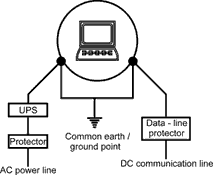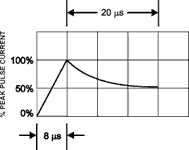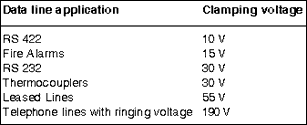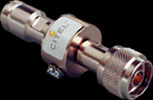
Today’s data equipment has become extremely vulnerable to a phenomenon known as voltage surges and electrical transients. A single IC package can contain over 100 000 memory bits and more than 5000 logic gates.
The high sensitivity due to the small size of the chips used in these packages makes them susceptible to quick degradation from voltage surges and transients. PLCs, MUXs, HUBs, RTUs, scada, and telemetry equipment are especially vulnerable to electrical surges because of their low operation voltages. Many of these components can be damaged beyond repair by an electrical surge as low as 20 V.
Sources of electrical surges are numerous. The most common is a nearby lightning strike, which will affect nearby data lines through induction. Industrial transients are also significant because they are man-made disturbances caused by switching and commutating of electrical motors. The operation of such devices can cause abrupt shifts in the ground potential that can generate a current flow through a nearby data-line in order to equalise the ground potential.
Electrostatic discharge is another form of an electrical surge that can be included in this group. Although often overlooked, (ESD) can potentially be a very harmful transient to fragile data equipment. ESD occurs due to two non-conducting materials rubbing together, causing electrons to transfer from one material to another.
The consequences of electrical surges and transients may be severe. Although the life span of these electrical phenomena is very short, the amount of energy that is carried can be extremely high. A typical transient event can last from a few nanoseconds to several milliseconds carrying several thousand volts and at least a few hundred amps of current. These events may cause burnt-line cards, lockups, loss of memory, problems in retrieving data, altered data, garbling...etc.
Protecting datacoms equipment with external TVSS
Any piece of equipment can be considered as having a circle around it which can be broken in two ways; through the power line or through the communication line (ie, telephone line, coaxial line, RS232, RS422, RS485, RS423, and 4-20 mA current loop cables). Figure 1 illustrates how a piece of equipment such as a computer can be affected. Both the AC power line and the DC communication line provide direct paths to your equipment through which voltage surges and electrical transients can travel and damage your equipment.

It is vital that all surge protectors and UPSs be grounded to a common earth/ground. This avoids differences in ground potentials that may generate a current flow through a nearby data-line in order to equalise the ground potential.
In order to protect your equipment from incoming surges through the data-line, the user must first determine the electrical specifications of the equipment being protected. Generally, DC communication applications can be broken down into two categories: twisted-pair and coaxial.
Twisted-pair applications make up the most common form of wiring in data communications. It consists of two identical wires wrapped together in a double helix. Both wires in the pair have the same impedance to ground, making it a balanced medium. This characteristic helps to lower the cable's susceptibility to noise from neighbouring cables or external sources. One of the most common examples of a twisted-pair application is a telephone line. A single telephone line consists of two copper wires; one for transmitting electrical impulses and one to receive them. Coaxial applications, on the other hand, consist of a solid wire core surrounded by one or more foil or braided wire shields, each separated from the other by a plastic insulator. The inner core carries the signal, and the shield provides the ground. While it is less popular than twisted pair, it is widely used for television signals such as CATV (community antenna television).
Protecting twisted-pair applications
Once the type of application is determined, the proper type of surge protector must be selected. Whether it is twisted pair or a coaxial application, surge protection comes down to four essential questions. If the application is twisted pair, the four questions users should ask themselves are:
1. What is the nominal voltage of the application?
2. What is the transmission speed of the data that is being passed?
3. What is the current rating of the application?
4. How many pairs of these 'twisted pairs' does the application consist of?
In selecting a surge protector, the nominal voltage of the twisted pair application must be known in order to assign a proper 'clamping voltage'. According to Ohm's Law (V = IR): voltage is proportional to the current, keeping the series resistance constant. Once the voltage level reaches the surge protector's clamp voltage, the excess energy that may have damaged your DC communication equipment is diverted to a common earth/ground point. As a rule of thumb, the clamping voltage of a surge protector should not be more than 1,4 times the application's nominal voltage.
In addition to knowing your application's nominal voltage, the transmission speed must be obtained as well. This information deals with the capacitance being placed on your twisted pair line by the surge protector. This parameter is important for high-speed data rate applications such as Category 5, 10Base T, RS485 and T1/E1. Capacitance can cause signal loss or be the source of signal reflections if not properly used in a specific data line.
Identifying the current rating of the twisted pair application is just as significant as the transmission speed and clamping voltage. TVSS (transient voltage surge suppressors) devices for data lines such as RS485, 4-20 mA loops and telemetry equipment have current ratings of no greater than 200 mA. Applications that have higher current ratings (eg, 500 mA, 1 A, and 2 A) will cause premature failure to a surge protector made for low voltage data-lines.
While determining the last three parameters, a simpler question must be kept in mind: how many of these twisted pairs need to be protected? It is important to recognise that every wire connected to your equipment, even though it may not be in use, provides a path for harmful transients to reach your delicate equipment. In today's market, surge protectors are available from as little as one pair to 200 or 300 pair blocks.
Once all four parameters have been determined, the TVSS power handling capability also known as peak pulse current, or maximum discharge current, should be investigated. These terms are defined as the maximum current that the surge protector can withstand for a given pulse duration. Pulse duration can be characterised as the length of time needed for the peak pulse current to reach a maximum value plus the length of time needed for the peak pulse current to reach 50% of its peak value. Figure 2 illustrates an 8/20 μs waveform in which the power handling capabilities of most surge protectors are commonly tested.

The waveform is used to simulate 'real-life' lightning related surges. This is significant because the TVSS must be able to provide a low clamping voltage and be capable of diverting the lightning surge or industrial transient away from the DC communication equipment without short-circuiting.
Protecting coaxial applications
In a similar fashion, coaxial surge protection boils down to four essential questions that the user should ask him or herself:
1. What is the frequency range of the application?
2. What is the power rating?
3. What is the connector type of the application?
4. Is an in-line or bulkhead mounting style preferred?
Coaxial surge protectors are composed of either gas discharge tubes or quarter wavelength stubs. In both cases, the frequency in which your coaxial equipment must be known. For example, the operating frequencies of PCS and L-Band applications are approximately 1,92 GHz and 800 MHz respectively. Gas discharge tube surge protectors generally have operating frequencies up to 4 GHz with very low leakage currents and insertion losses. An N-type coaxial surge protector manufactured by Citel has insertion losses so low (0,066 dB at 2,5 GHz, 0,2 dB at 4 GHz) that the protector is practically transparent on the coaxial cable.
In addition to knowing the frequency of the coaxial application, the power rating must also be known to assign a proper clamping voltage. Standard gas discharge tube protectors are available to protect power ratings up to 50, 400 and 1000 W (continuous). Just like the twisted pair protector, once the voltage level reaches the surge protector's clamp voltage, the excess energy that may have damaged the DC communication equipment is diverted to a common earth/ground point.

In order to connect the surge protector directly to your coaxial apparatus, a compatible connector type must be chosen. Common connector types are N-type, BNC, TNC, SMA and 7/16 DIN.
The type of installation is also an issue to take into consideration. Typical mounting styles are available in in-line and bulkhead types. In-line protectors mount directly in series with the coaxial cable and grounding is done through an external ground screw that is attached to the body of the surge protector. The advantage to in-line protectors is that they are very easy to install and they are ideal for retrofit applications. Bulkhead coaxial protectors are different only in the way they are grounded. Grounding is done through the chassis of the protector and the excess energy is discharged through the panel that it is mounted on. Bulkheads provide better electrical contacts for discharging excess energy from an electrical surge. Figure 3 shows Citel's version of the two types of coaxial surge protectors.

Conclusion
Today's data equipment has become extremely vulnerable to a phenomenon known as voltage surges and electrical transients. Users should be aware of the danger that voltage surges, industrial transients and electrostatic discharges can bring to their expensive and delicate communication equipment. Without data circuits being adequately protected, the door is left open to those damaging electrical surges. Steps should be taken to identify the type of DC communication equipment that needs protection and to find the best kind of surge protection for a particular piece of equipment.
Companies such as Citel have designed fast acting, low clamping, high discharge surge protectors for all types of DC communication lines to divert to ground all damaging transient voltages while remaining transparent. Communication line surge protection has been overlooked for a long time and cannot be ignored any longer.

© Technews Publishing (Pty) Ltd | All Rights Reserved